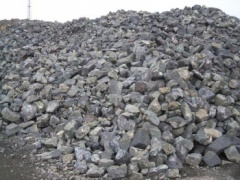Chromium Ore
| Infobox on Chromium Ore | |
|---|---|
| Example of Chromium Ore |  |
| Facts | |
| Origin | See text |
| Stowage factor (in m3/t) | 0,33/0,45 m3/t (bulk) |
| Humidity / moisture | - |
| Ventilation | No special requirements |
| Risk factors | See text |
Chromium Ore
Contents
Description
Chromium ore is a natural mineral formation (lumpy, dark grey in colour) containing chromium in such compounds and concentrations as to make its commercial exploitation technically feasible and economically expedient.
The only chromium-containing minerals that provide an industrial source of chromium are the chrome spinellids. In addition to chrome spinellids, the primary minerals of chrome ores are the silicates, including serpentine, chlorite, and sometimes olivine, pyroxene, plagioclase, uvarovite, chrome actinolite, talc, and brucite, and the carbonates and sulfides.
A distinction is made between solid and impregnated chrome ores. The latter are further subdivided into densely impregnated (50–80 percent chrome spinellids), heavily impregnated (30–50 percent), and lightly impregnated (10–30 percent). Different combinations of massive structures with banded, mottled, nodular, and other types of structures are observed. The quantity of the leading components in chrome ores varies as follows: 10.5–62.0 percent by weight Cr203, 4.0–34.0 percent Al2O3, 1.0–18.0 percent Fe2O3, 7.0–24.0 percent FeO, 10.5–33.0 percent MgO, and 0.4–27.0 percent SiO2. Certain chrome ores contain 0.1–0.2 g/ton of the platinum group elements and up to 0.2 g/ton of gold. The harmful impurities S, P, and Ca constitute more than 1.0 percent.
The chief deposits of chrome ores in the USSR are in the Urals at the Donskoe and Sarany deposits. The principal deposits abroad are in the Republic of South Africa (the Bushveld complex), Zimbabwe (the Great Dike and Selukwe), Turkey (Guleman and elsewhere), the Philippines (primarily on the island of Luzon, at Masinloc and elsewhere), India (Sukinda and elsewhere), Finland (Kemi), and Madagascar (Andriamena).
See also Ores











